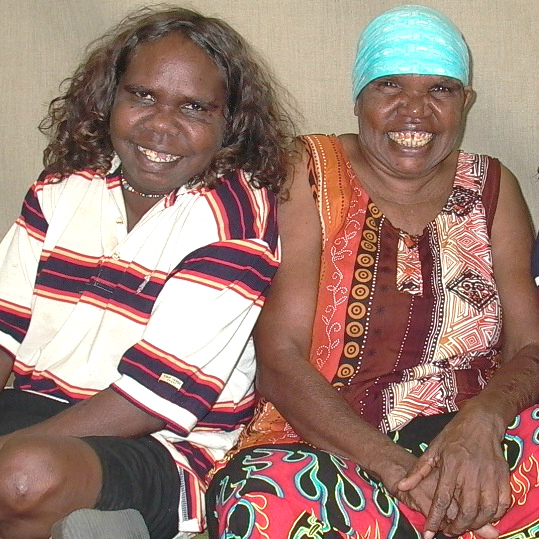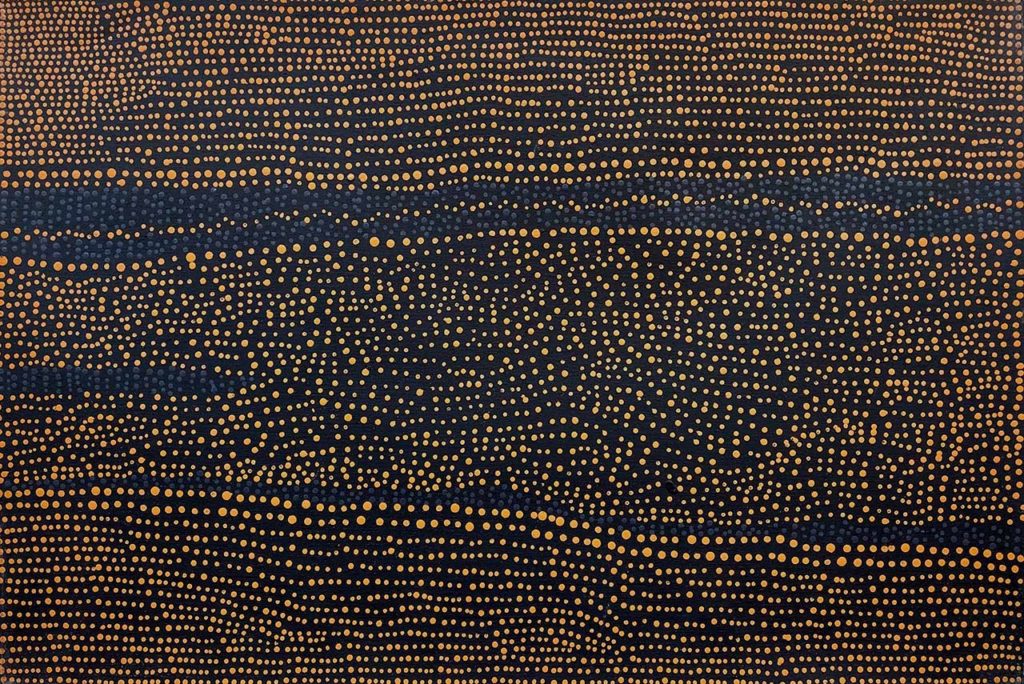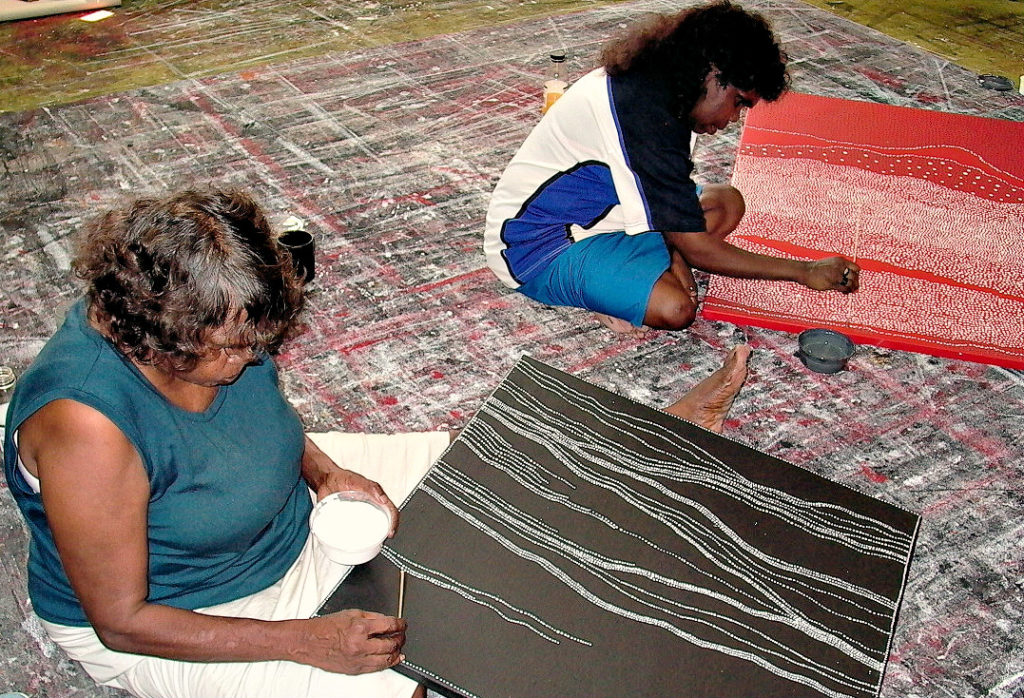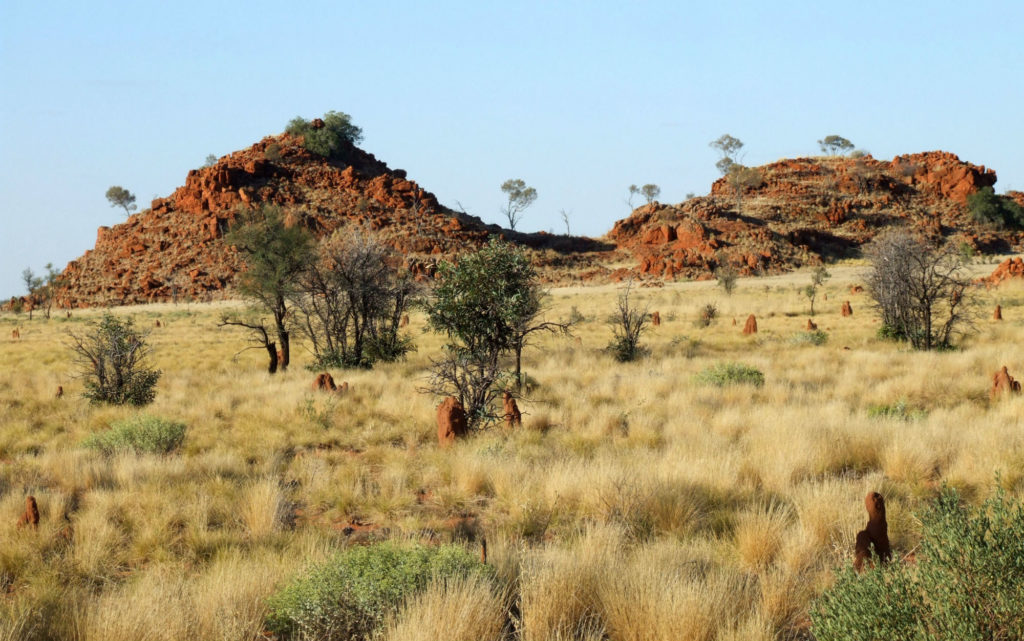Julie Nangala Robinson Pirlinyanu Exhibition
Dorothy Napangardi's Manager and long time friend, Roslyn Premont talks about Julie Nangala Robinson. Julie is one of Dorothy’s daughters and she is about to launch her solo exhibition at Japingka Gallery.

Can you tell me a little bit about how you know Julie Nangala Robinson?
Julie is the eldest of Dorothy Napangardi's five daughters. I first met her at the Government Gallery in 1987, so she was quite young then. She's quite a shy character, like Dorothy. In contrast, some of Dorothy's other daughters, like Sabina, are quite talkative and outgoing, whereas Julie is much more gentle and quiet. She was christened Shirley, but Julie was the name that everybody called her.
How did she begin painting?
Julie was always coming into the studio with her mother Dorothy. She'd be sitting beside her, that's how she learned to paint.
(Feature Image Above: Julie Nangala Robinson | Pirlinyanu | Jap 017250)
What is the relevance of the word Pirlinyanu - the title of some of the paintings and her new exhibition?
Pirlinyanu is actually a rocky outcrop with many rock holes. It's north west from Nyrripi, a community west of Yuendumu. It's a very big Water Dreaming site. In this little mountain, the natural rock formation makes water containers, so it is important to keep these areas clean. When the rain comes, they are covered with rock to protect the site from getting dirty as it is a very important water source. It's also a very important part of the Water Dreaming story from that region. It belongs to both the Nangala/Jangala and Nampijinpa/Jampijinpa skin groups. So her Ngapa Tjukurrpa is the Water Dreaming story. In this culture your Dreaming is patrilineal, so it's her father's Dreaming. You have the right to paint stories relating to Dreaming that comes through your father's line.
You also have to right paint your mother's Dreaming, but it's not your primary Dreaming. Your primary Dreaming is through your father and your father's sisters, which are the aunties. The aunties are responsible for the ritual knowledge, whereas your mother is responsible for everyday kind of knowledge. You learn your ritual knowledge and your Dreaming story through your father's sisters.
How do you think her style of art has been influenced by her mother?
I think there was definitely an influence, because she kept so close to her mother all the time. I think she had a huge influence on her. Dorothy's work is very precise and very neat. I would have paint all over the place. She would come away with very little paint on her hands or dress. Julie is similar in that regard. She has a rhythm to her dots, so I often think it reminds me of falling rain. Her mother of course has that as well. So I think in the rhythm and in the application, the attention to detail, the quality of her work is similar to her mother.

Julie seems to be able to work on large canvases?
Beautifully. They're lovely. If you put a large blank canvas in front of her, really large ones, she always responds positively. The large canvases bring out a different quality to her work.
The large works often attract the attention of collectors who have the space to hang a work like that. They are spectacular and in the right environment, collectors say the impact is amazing.
What does Julie say about the big canvases, does she have a preference for them?
Yes she loves big canvases. She loves working in monochromatic paints. She loves red, adored working in red and whites and especially working on a big canvas. She felt that she could explore the rhythm in her dots. I think the rhythm of the dot was key for her. She would express things like the build up of the storms sometimes in the colour tones that she would use. I mean, because when you're learning to ‘sing up’ rain and take care of the area and all that, a lot of it is imagining rain coming and how it tends to form on the rocks. And how when it hits the rocks, it bounces across and flows into the rock holes. I think on a large format you could actually imagine that.

So the restricted palette of colours is an essential part of this artist's work, isn't it?
Yes, it is. She has never really tended to explore colour very much. She is drawn toward opaque colours rather than the more vibrant tones.
Are other painters in the family?
In her immediate family, the main ones are Dorothy and her sister Sabrina, who is the second born of the five. Sabrina is also incredibly talented, but she's not as driven as Julie. Julie has got the nature of the mother, not only quiet, but also quite driven. She really loves to paint. She really enjoys doing one thing. Sabrina might be here periodically and not all the time. Julie takes the work very seriously and I think the other family members respect that.
One of the sisters has passed away. So there's now only four daughters left. The youngest daughter has no interest at all in painting. Even when she was little she showed more interest in other things.
The exhibition shows work by Julie over a period of time. Is this showing how she's emerged as an artist?
Yes, it is. I think Julie is becoming more self-assured and confident.

Do you think that the legacy of famous artists like Dorothy can be successfully carried forward and extended by younger generations of the family?
Yes, I think so. Dorothy is a groundbreaker, she pierced the ground when she was doing things at a time that nobody else was doing them. Now we can see other people exploring the similar subject matter. Dorothy was really ahead of the times. Julie got to see the respect that Dorothy was given and the recognition of her achievements. The girls would see that and would feel very proud of that, and they would also understand the importance of it. I think this is where the path is made easier for the next generation if they have talent. Just to be in the company of people who have been recognised rubs off. Perhaps they think I can see where this is important and I would like to continue this.
You have to have the talent. Not everybody from the family of a famous artist has talent, but if they've got a talent they are more likely to succeed because it's not such a strange environment for them. They understand the process. The other family members would have explained how it works within the gallery or what percentage you would get, and what the studio environment offers an artist. That kind of thing would be passed on so it's not a new environment. It's more of an environment they comprehend and feel comfortable being a part of.
What's it been like working with such a talented family group as Dorothy and Julie?
It's been fantastic. It's been sensational really. Inspiring. I feel very proud of them. I have had a great friendship with Dorothy and her daughters since they were small. So it's been lovely watching them have children, watching them grow to beautiful women. It's been a privilege actually. To have been recognised well by such family, to be closely connected with family.
Do you think that it's a unique experience, this kind of relationship, or is it a feature common to a number of Aboriginal families that there's a tradition then you get to know multi-generations?
I think it's tradition. It's not just my experience. Once you've worked closely with someone, you are accepted into the family as such. Once you're given a skin name. That comes with everything, it comes with the good and the difficult. It comes with the intimacy of knowing people very well, it also comes to a lot of responsibility within the family.
I've seen it now with people that I've known, other colleagues who have worked with artists. Sometimes I can watch from afar. If you're not involved in it, if you haven't experienced that, it's been difficult to even comprehend how integrated you become in the everyday lives of people. If something goes wrong, something happens, some relatives are in need, you're completely immersed in their lives. That's just how it evolves.

View: Julie Nangala Robinson
